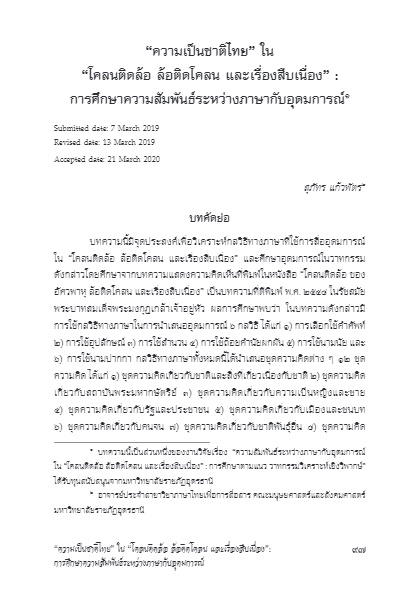“ความเป็นชาติไทย” ใน
“โคลนติดล้อ ล้อติดโคลน และเรื่องสืบเนื่อง” :
การศึกษาความสัมพันธ์ระหว่างภาษากับอุดมการณ์
สุภัทร แก้วพัตร
บทคัดย่อ
บทความนี้มีจุดประสงค์เพื่อวิเคราะห์กลวิธีทางภาษาที่ใช้การสื่ออุดมการณ์ใน “โคลนติดล้อ ล้อติดโคลน และเรื่องสืบเนื่อง” และศึกษาอุดมการณ์ในวาทกรรมดังกล่าวโดยศึกษาจากบทความแสดงความคิดเห็นที่พิมพ์ในหนังสือ “โคลนติดล้อ ของอัศวพาหุ ล้อติดโคลน และเรื่องสืบเนื่อง” เป็นบทความที่ตีพิมพ์ พ.ศ. ๒๕๔๘ ในรัชสมัยพระบาทสมเด็จพระมงกุฎเกล้าเจ้าอยู่หัว ผลการศึกษาพบว่า ในบทความดังกล่าวมีการใช้กลวิธีทางภาษาในการนำเสนออุดมการณ์ ๖ กลวิธี ได้แก่ ๑) การเลือกใช้คำศัพท์ ๒) การใช้อุปลักษณ์ ๓) การใช้สำนวน ๔) การใช้ถ้อยคำนัยผกผัน ๕) การใช้นามนัย และ ๖) การใช้นามปากกา กลวิธีทางภาษาทั้งหมดนี้ได้นำเสนอชุดความคิดต่าง ๆ ๑๒ ชุดความคิด ได้แก่ ๑) ชุดความคิดเกี่ยวกับชาติและสิ่งที่เกี่ยวเนื่องกับชาติ ๒) ชุดความคิดเกี่ยวกับสถาบันพระมหากษัตริย์ ๓) ชุดความคิดเกี่ยวกับความเป็นหญิงและชาย ๔) ชุดความคิดเกี่ยวกับรัฐและประชาชน ๕) ชุดความคิดเกี่ยวกับเมืองและชนบท ๖) ชุดความคิดเกี่ยวกับคนจน ๗) ชุดความคิดเกี่ยวกับชาติพันธุ์อื่น ๘) ชุดความคิดเกี่ยวกับผู้ใหญ่และผู้น้อย ๙) ชุดความคิดเกี่ยวกับประชาธิปไตย ๑๐) ชุดความคิดเกี่ยวกับการเป็นพลเมืองที่ดี ๑๑) ชุดความคิดเกี่ยวกับพุทธศาสนา ๑๒) ชุดความคิดเกี่ยวกับความเป็น “พวกเขา” “พวกเรา” จากชุดความคิดทั้งหมดนี้สามารถสื่ออุดมการณ์ที่แฝงอยู่ในวาทกรรมดังกล่าวได้ ๓ อุดมการณ์ คือ ๑) อุดมการณ์ “ราชาธิปไตย”๑)อุดมการณ์ “ชาตินิยม” และ ๓) อุดมการณ์ “ปิตาธิปไตย” วาทกรรมนี้ได้นำเสนอแนวความคิดเกี่ยวกับ “ความเป็นชาติไทย” เพื่อต้องการให้คนไทยมีความจงรักภักดีต่อชาติ ศาสนาและพระมหากษัตริย์ ในขณะที่สภาพสังคมทั้งภายในและภายนอกประเทศกำลังเปลี่ยนแปลงไปสู่ยุคการปกครองแบบประชาธิปไตย
คำสำคัญ: ภาษา, อุดมการณ์, วาทกรรมวิเคราะห์เชิงวิพากษ์
(ตีพิมพ์ใน วารสารไทยศึกษา ปีที่ 16 ฉบับที่ 2 (กรกฎาคม-ธันวาคม 2563) หน้า 97 – 138)
“Thainess” in “CLOGS ON OUR WHEELS,
OUR CLOGGED UP WHEELS, AND THE OTHER
RELATED STORIES” : A study of the relationship
between language and ideology
Suphat Kaewphat
Abstract
This article aims to analyze the ideological linguistic strategies in “Clogs on Our Wheels, Our Clogged up Wheels, And the Other Related Stories”, and to analyze the discourses through critical articles in the book written by Asawabhahu “Clogs on Our Wheels, Our Clogged up Wheels, And The Other Related Stories”, published in 1915 during the reign of King Rama VI. Results of the study indicated that six linguistic strategies were used to present ideology: 1) lexical selection; 2) metaphor; 3) idioms; 4) verbal irony; 5) metonymy; and 6) pseudonym. These linguistic strategies presented 13 mindsets: 1) nationality mindset; 2) monarchy mindset; 3) gender mindset, male and female; 4) state and people mindset; 5) city and rural mindset; 6) poverty mindset; 7) ethnic groups mindset; 8) senior and junior mindset; 9) democracy mindset; 10) good population mindset; 11) Buddhism mindset; 12) ‘Theirs’ and ‘Us’ mindset; and 13) parents mindset. These mindsets show three latent ideologies in the discourse: 1) monarchy; 2) nationalism; and 3) paternalism. These discourses demonstrate ideas about Thainess to make Thai people loyal to the concept of Nation, Religion and Monarch because the situation of Thailand, both inside and outside the country, was transforming into a new regime, democracy.
Keywords : Language, Ideology, Critical Discourse Analysis ( CDA)
(Published in Journal of Thai Studies Volume 16 Number 2 (July – December 2020) Page 97-138)
บทความ/ fulltext :4_Supat.pdf
